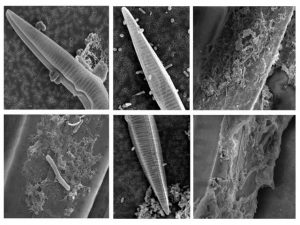A new study supported in part by the NCCOS Monitoring and Event Response for Harmful Algal Blooms ( MERHAB ) finds the harmful algal bloom (HAB)-forming diatom Pseudo-nitschia (PN) maintains a distinct bacterial community living on and near its exterior cell wall.The findings offer new insights into possibly using bacteria as indicators of HAB species composition, control of HABs, toxin degradation, and cholera research.

Bacterial species diversity decreases with increasing PN numbers and on species of PN with higher toxicity suggesting that the presence of the algal toxin domoic acid can influence the bacteria community. Additional findings suggest that as algal species diversity changes in a bloom so does the bacterial species diversity; evidence that algal species and bacterial species are tightly coupled, keeping a close, perhaps symbiotic-like association . Associated bacteria include groups ofthe genus Vibrio , a genera that includes the species causing vibriosis and cholera diseases in humans.
Overall, study results suggest that phytoplankton-associated bacterial communities are highly affected by the numbers of algal individuals in a bloom and also by the type of algal species that dominates a bloom. The study is published in the journal Frontiers in Microbiology, section Aquatic Microbiology.
For more information, contact Marc.Suddleson@noaa.gov.
